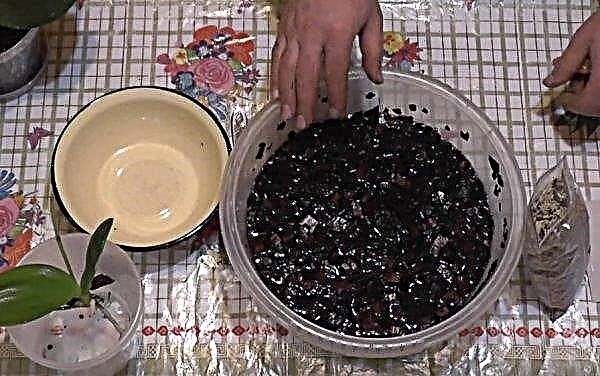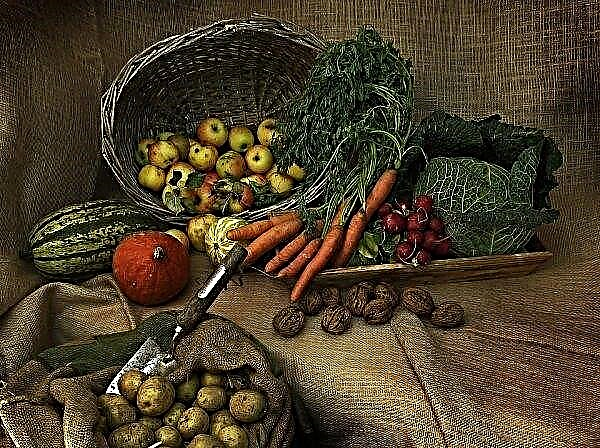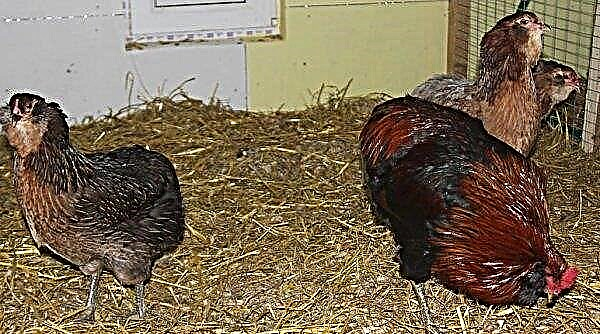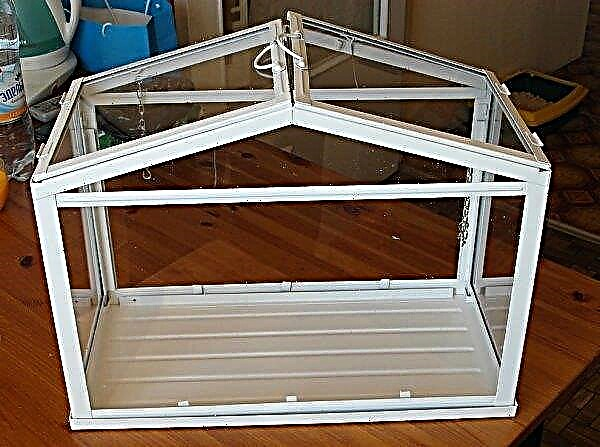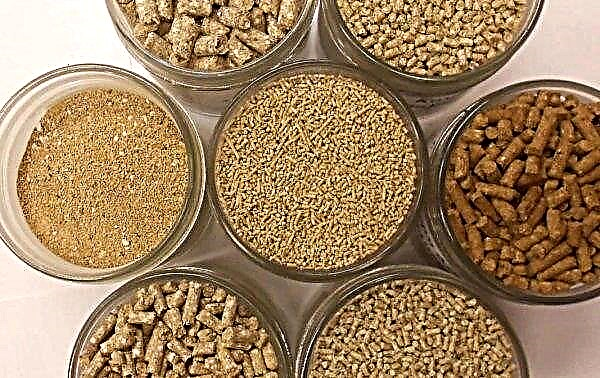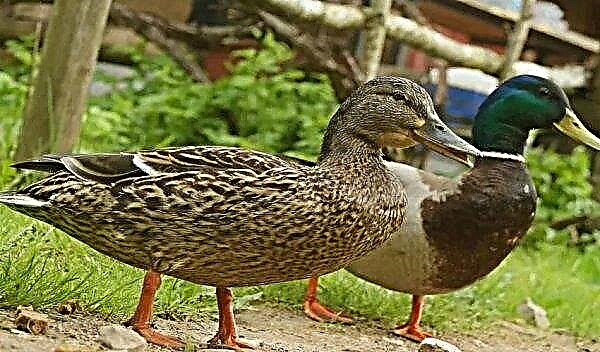At present, several tens of thousands of hybrids of the senpole have been bred. These beautifully flowering houseplants, depending on the variety, differ mainly in the shape and color of the flowers. A popular representative of the blue-blue senpolia is the violet Blue Dragon, with a description, the features of care and reproduction, as well as possible problems with the cultivation of which we will meet in this article.
Botanical description of the plant
The violet variety Blue Dragon was bred by the American company Lyndon Lyon’s Greenhouses, which is engaged in the cultivation and cultivation of new hybrids of senpolis and is focused on consumer requests. Her breeding was done by professional breeders. This variety has large rosette sizes (30–45 cm) with leaves having a dark green color on top and a green-red bottom. Petioles of leaves directed upwards.
Did you know? Currently, there are miniature varieties of senpolia, whose rosette is not more than 6 cm. The largest varieties can reach 60 cm.
And along the edges of the leaf plates, small cloves are observed. When buds appear, foliage curls somewhat, and during flowering it returns to its original state. Under favorable conditions, one instance can produce up to 50 flowers. Each peduncle contains from 3 to 5 large double or semi-double flowers with sizes of 5-6.5 cm.
They have a beautiful blue color with a blue eye and a purple border with corrugated edges that are painted in light green. With proper care, the violet Blue Dragon blooms almost continuously. In a cool room, the blue color is most pronounced, and in the heat the border may be lost, white spots may appear.

The conditions for growing violets at home
In order for the Blue Dragon violet to show its best side, you need to keep it under optimal conditions for the variety.
Location and Lighting
The window sills on the west or east side of the house are best suited to the Senpoly. On the windows of the southern orientation they will need to be shaded. In a hot sun, shading from direct sunlight is also needed on other windows (except the north).
With the northern location of the senpolia, they feel great in the warm period, but in the cold, they have little sun. The plant requires lighting lasting at least half a day. In winter, to stimulate flowering, it must be illuminated with phytolamps up to 11-15 hours.
Pay attention also to other types and varieties of violets:
Temperature and humidity
The optimal temperature regime for violets of the Blue Dragon variety is in the range + 20 ... + 22 ° C. Sudden changes in temperature and drafts should be avoided, especially when airing in winter. Humidity should be at the level of 50–70%.
Spraying with water should be avoided. Allowed fine spraying during flowering. To increase humidity, the container with senpolia can be put in a beautiful tray with decorative moistened pebbles or a room fountain can be placed next to it. You can use a humidifier.
Basic rules for home care
It’s easy to take care of a Blue Dragon violet.

Watering
The soil in the pot should not dry out, but excess moisture is also not acceptable. Water should not fall on the upper green part of the plant, as this can cause the process of decay or burns from the sun. For irrigation use settled water at room temperature.
In winter, it is recommended to warm it up a bit. Water is poured along the edges of the pot. For convenience, use a small watering can with a narrow nose or a pear for douching. You can also make a hole in an ordinary plastic bottle in the cap and insert a tube into it. Excess water from the pan must be drained.
Important! Saintpaulia is better to water less often than to flood. Excessive moisture provokes decay.
Many experienced flower growers use lower watering - they put a flower pot in a container with water for 20-30 minutes, the level of which reaches 2/3 of the pot. Wick irrigation is considered the most acceptable. To conduct such irrigation, a wick from the cord is inserted into the hole in the pot, which is lowered into a container of water. It is very convenient if the owner of the violets leaves somewhere for 1-2 weeks. In the summer, watering is made more plentiful, and in winter the intensity of watering is reduced.
Fertilizer application
Top dressing is best done with special liquid fertilizers. Young specimens that build up green mass are more in need of nitrogen. Older senpolia, which are ready for flowering, require fertilizing with potassium and phosphorus. For fertilizing, liquid fertilizers for flowering indoor plants are perfect. They should be used 1-2 times in 30 days.

When using fertilizers, the recommended standards in the instructions should be adhered to. Excess chemical elements contained in the fertilizer can adversely affect the growth and development of the plant.
When planting and transplanting into fresh soil, violets can not be fertilized for 2 months. There will be enough nutrients in the soil for its growth. For top dressing, you can sometimes use such well-known home remedies as black tea, coffee grounds, a solution of baker's yeast.
Important! Saintpaulia is fed during the flowering period. If the plant is not lightened in winter and it does not bloom, it is at rest, then it does not need top dressing. Do not feed sick or affected specimens.
Pruning
Trim violets for the following reasons:
- Removing excess leaves contributes to more abundant flowering.
- Trimming the top of the old senpolia rejuvenates the plant. On the remaining hemp over time, children grow up, which are used for reproduction.
- It is necessary to trim leaflets affected by various diseases in order to prevent the spread of the disease.

As growth and development should be cut old and spoiled leaves, as well as faded peduncles. For an overgrown flower, side rosettes should be cut. Leaf removal is easy. To do this, press a fingernail at the base and tear off excess leaves by twisting. They can also be simply cut with sharp scissors. If, after breaking off the lower leaves, the trunk is exposed, then a little soil should be added.
Transfer
Violet as it grows, is transplanted into a new pot about 1 time in 2-3 years. The process is carried out when the plant does not bloom. Usually this is the month of March. To transplant this indoor flower, the method of transshipment of an earthen coma is used, which allows injuring the root system as little as possible.
For this purpose, take a small and shallow pot, since the root system of violets is not particularly developed, and large excess soil can begin to sour, which will cause the appearance of some fungal diseases. The pot must have an opening for the release of excess moisture. At the bottom, a 3 cm drainage layer of expanded clay or pebble is necessarily placed.

As a soil for planting, nutritious loose soil with an acidity of 6.5–6.7 pH is suitable. Ready-made soil for transplanting can be purchased at the garden store, or you can prepare it yourself. The following mixture is well suited for this purpose - 5 parts of leafy land, 3 parts of peat and 1 part of river sand.
Charcoal and sphagnum can be added to this mixture. Before use, the soil mixture must be decontaminated to avoid the appearance of various fungi and bacteria. To do this, it is poured with boiling water or calcined in the oven (it is possible in the microwave).
Did you know? In the language of flowers, violet is a symbol of innocence and shyness. In England, it is often presented to each other by lovers on Valentine's Day.
On the eve of a transplant, a flower is watered. If rotted root sections are found in a plant, then they are trimmed, and the soil is completely changed. When transplanting, lower and damaged leaves are removed. An overgrown plant is divided into sockets. The transplant itself is carried out in a sufficiently moist soil and is not very compacted. Then watering is carried out in 2-3 days.
How to propagate at home
Saintpaulia The blue dragon propagates by leaves and daughter rosettes.
Cuttings
The most common method of propagating violets is cuttings. This process is carried out in the spring. To do this, cut the leaves and germinate them. It should be noted that the length of the petiole should be at least 1.5 cm.
Cuttings can be rooted in the following ways:
- In water. For this, stalks are placed in a container with a small amount of water. Water must be left standing. After the appearance of the roots, the stalk is planted in a prepared pot with soil.
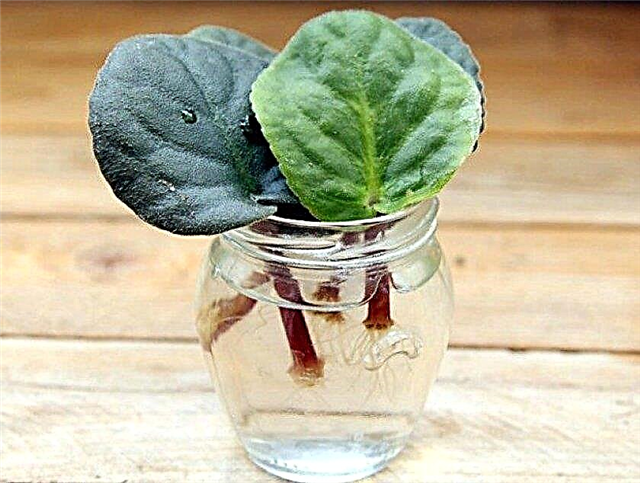
- In the ground. To do this, the stalk is planted in a prepared substrate and create a greenhouse effect, covering the planting with a bag of polyethylene. Every day, control the hydration and air for 15 minutes. After the cuttings give roots, they are planted in separate pots.
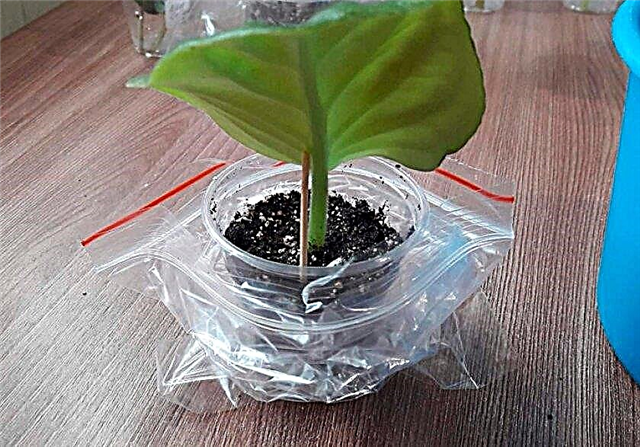
Dividing the bush
When the violet grows well, reproduction can be done by dividing the bush. This is usually done with a flower transplant. In this case, the flower is removed from the container and daughter sockets are carefully separated along with the roots. They are immediately placed in separate pots and monitor the moisture content of the substrate.
Growing difficulties
When growing violets, the Blue Dragon can encounter certain difficulties. So, with excessive watering and other irregularities when caring for these indoor flowers, such fungal diseases can occur:
- Powdery mildew. The disease can be detected by the appearance of a whitish coating on the leaves. To get rid of such a nuisance, chemical preparations like “Baytleton”, “Topaz” are used. Sulfur powder gives a good effect. They sprinkle a plant on them and put on a plastic bag.

- Gray rot. With the defeat of this disease, a gray coating is found on the senopoly. Infection often comes from neighboring plants. To combat this nuisance, fungicidal drugs (Fundazolum) are used.

Great damage to the violet can be caused by the appearance of the following pests of indoor flowers:
- Whitefly. These small insects leave a sticky coating at the bottom of the leaves, where the soot fungus often begins to appear. The larvae of this pest feed on plant sap. To combat them, they use insecticidal drugs and chemicals such as "Actofit", "Fitoverm".

- Mealybug. It is detected by a cotton-like formation on the leaves and root system of violets. These small insects drink juice by the flower. To fix the problem, you need to clean the green part of the plant with a soapy solution, and then apply insecticidal preparations such as "Actara". Be sure to replace the soil in the pot.

- Cyclamen tick. It affects young leaves in the center of the plant. Yellow spots appear on them, and the shape of the leaves is deformed. In this case, the flower is cleaned with a sponge dampened in soapy water and the Aktellik or Fitoverm chemicals are used. The treatment is repeated after 7-10 days.

To prevent the occurrence of pests and diseases, it is necessary to take high-quality planting material, disinfect the soil, observe all the rules for caring for violets. To prevent the appearance of fungi, it is recommended that spraying be carried out in the cold period every 30 days with Confidor. To increase the resistance of the flower to various diseases, they are treated with the immunocytophyte drug.
Thus, observing the simple rules of caring for this plant, it is completely possible to grow and propagate this flower at home and enjoy its beautiful flowering.Did you know? It is believed that in a room in which violets grow and bloom, it is necessary to make a children's room or bedroom.









